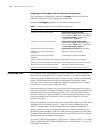
176 CHAPTER 6: MULTICAST PROTOCOL
■ Configuring the IGMP Querier Present Timer
■ Configuring the Maximum Query Response Time
■ Deleting IGMP Groups Joined on an Interface
■ Displaying and Debugging IGMP
Enabling Multicast
After multicast is enabled, IGMP will automatically run on all interfaces.
For details, see “Configuring Common Multicast ” on page 172.
Enabling IGMP on an Interface
You must enable multicast before you can execute the igmp enable command.
After this, you can initiate the IGMP feature configuration.
Perform the following configuration in VLAN interface view.
By default, IGMP is not enabled.
Configuring the IGMP Version
Perform the following configuration in VLAN interface view.
The default is IGMP Version 2.
All routers on a subnet must support the same version of IGMP. After detecting
the presence of IGMP Version 1 system, a router cannot automatically switch to
Version 1.
Configuring the Interval for Sending the IGMP Group-Specific Query
Packet
In the shared network, where the same network segment includes multiple hosts
and multicast routers, the query router is responsible for maintaining the IGMP
group membership on the interface.
When the IGMP v2 host leaves a group, it sends an IGMP Group Leave message.
When the IGMP query router receives the IGMP Leave message, it must send the
IGMP group query message for the specified number of times ( the robust-value
parameter in the igmp robust-count command, with a default value of 2) in a
specified time interval (the seconds parameter in the igmp
lastmember-queryinterval command, with a default value of 1 second).
Table 8 Enable/Disable IGMP on an Interface
Operation Command
Enable IGMP on an interface igmp enable
Disable IGMP on an interface undo igmp enable
Table 9 Select the IGMP Version
Operation Command
Select the IGMP version that the router uses igmp version { 2 | 1 }
Restore the default setting undo igmp version


















